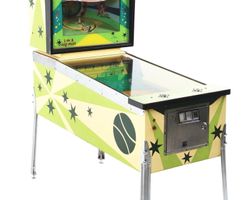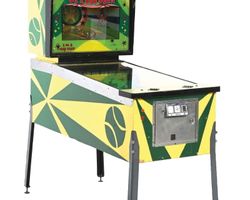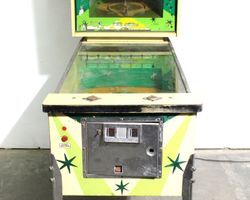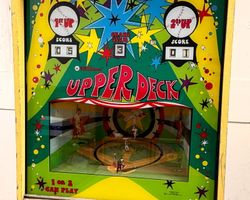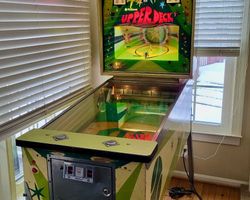Upper Deck
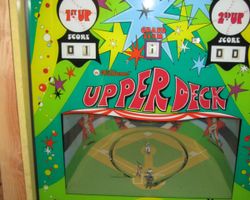
Average Prices: USD $600 to $1,800
Produced: Febuary, 1973
Production Run: 1,250 units
Machine Type: Electro-mechanical
Players: 2
Williams Electronic Games, Inc., a prominent name in the amusement industry, released Upper Deck in February 1973. This electro-mechanical (EM) machine distinguished itself within the company's long line of sports-themed titles, specifically as a "pitch and bat" baseball game. Upper Deck represented a notable point in Williams' production history, being the final EM baseball game manufactured by the company. Its design focused on replicating the core dynamics of a baseball match, from pitching the ball to the player's attempt to hit it.
The creation of Upper Deck unfolded during a transitional period for pinball, as manufacturers began experimenting with early electronic elements while still relying heavily on established EM technology. With a production run of 1,250 units, manufactured between February 1st and May 11th, 1973, Upper Deck offered a familiar yet refined take on the popular baseball pinball genre. Its design aimed to deliver an engaging experience through mechanical ingenuity, combined with innovative sound elements for its era.
Signature Features and Design
Upper Deck's appeal stemmed from its integration of mechanical action with early sound capabilities. At the heart of its design was the ball pitching and batting mechanism, which allowed the game to simulate the back-and-forth of a baseball game. Unlike later designs that might incorporate buttons for batting, Upper Deck featured a traditional batting handle, providing a tactile connection to the game's theme and giving players the physical sensation of swinging a bat. This dedication to simulating the sport’s actions contributed to its immersive quality.
A distinctive element of Upper Deck was its two-level playfield, connected by a full ramp. This elevated section expanded the play area, introducing different trajectories and scoring opportunities for batted balls. In the backbox, a mechanical animation unit, often referred to as the "running man unit," visually tracked the progress of runners on bases. This feature provided immediate feedback on the game's status, enhancing the narrative of a baseball game in progress.
Beyond its mechanical features, Upper Deck incorporated electronic sound effects, a significant enhancement for an EM machine of its time. These sounds were designed to punctuate gameplay milestones: a cannon firing upon scoring a run, whistling for doubles and triples, and fireworks or sirens to celebrate a home run. These audio cues were specifically tailored to the baseball theme, providing immediate, exciting feedback for player actions.
Playfield and Mechanics
The playfield of Upper Deck is laid out to simulate a baseball diamond, albeit in a stylized form. The primary action revolves around the batting area at the bottom, where the player controls the bat. Pitched balls descend towards the bat, and the player's goal is to hit the ball strategically.
Successful hits send the ball up the playfield. The two-level design and the full ramp offer distinct pathways. A well-placed hit might travel up the ramp to the upper playfield, where different targets or openings represent base hits like singles, doubles, triples, or even home runs. The lower playfield offers alternative targets for less powerful or precise hits. The layout is designed to encourage precise batting, as different areas of the playfield correspond to different outcomes on the baseball diamond.
Artwork on the playfield and backglass further reinforced the baseball theme, depicting players, a stadium, and scoreboard elements. While adhering to the visual style of its era, the aesthetic focused on clarity and thematic representation. Lighting on the playfield primarily served to highlight active scoring areas or indicate game status, guiding the player's attention during play. The combined effect of the mechanical components, the multi-level playfield, and the integrated visual and auditory feedback created a cohesive and engaging baseball simulation.
Gameplay Dynamics
Gameplay in Upper Deck centers on the fundamental mechanics of pitching and batting. The machine pitches a ball towards the player's controlled bat, requiring timing and precision to make contact. The objective is to achieve "hits" that translate into advancing runners around bases and scoring runs, mimicking the progression of a baseball game.
The scoring system is straightforward and directly tied to the baseball theme. Hits result in players advancing on virtual bases, represented by the mechanical running man unit in the backbox. A single hit moves a runner one base, a double two, and so on. The ultimate goal is to move runners through all bases to score a run. The game accommodates two players, fostering competition as each player attempts to outscore the other over a customizable number of innings, typically one, two, or three.
Specific game events trigger unique audio cues, adding to the immersion. Scoring a run is celebrated with a cannon sound, doubles and triples are marked with whistling, and a home run elicits the sounds of fireworks and sirens. These audio highlights provide immediate, satisfying feedback for successful plays. Player strategy often involves attempting to hit the ball with enough power and accuracy to send it towards the most lucrative targets on the playfield, aiming for multi-base hits or home runs to maximize scoring potential. The subtle variations in pitching the ball also add a layer of challenge, requiring players to adapt their timing.
Reception and Legacy
Upper Deck generally garnered a positive reception, especially among those who appreciate the unique niche of pitch and bat games. Its integration of early electronic sound with an EM foundation was a notable strength, with many considering its audio effects to be a high point for baseball-themed pinball machines of its era. The cannon sound for runs, the whistling for multi-base hits, and the fireworks for home runs were particularly well-regarded for enhancing the game's celebratory moments.
Players consistently praised the game's engaging and enjoyable nature. The inclusion of the traditional batting handle, as opposed to simpler push buttons or levers, was a significant draw, offering a more authentic and satisfying batting experience. The two-level playfield and the full ramp were also highlighted as features that enriched gameplay and added depth to the action. The mechanical running man unit in the backbox was a key attraction, tying the visual progression directly to the gameplay and reinforcing the baseball theme. For many, the absence of this running man unit diminishes the appeal of other pitch and bat titles, underscoring its importance in Upper Deck.
While the gameplay and sound received widespread acclaim, some feedback noted that the artwork, while functional, might not have been as aesthetically intricate as some earlier titles. However, this was a minor point compared to the overwhelming positive sentiment regarding its playability and innovative features.
Upper Deck holds a distinct place in pinball history as Williams' final electro-mechanical baseball game. This status alone lends it historical significance within the company's extensive catalog. Its design served as a culmination of Williams' experience with EM pitch and bat mechanics, augmented by the incorporation of cutting-edge sound technology for the time. This fusion demonstrated a transitional moment in pinball manufacturing, bridging the gap between purely mechanical games and the fully electronic machines that would soon dominate the market. Its lasting reputation is built on its compelling gameplay, the satisfying action of its traditional batting mechanism, and its memorable audio, ensuring its continued appreciation within the community of pinball enthusiasts and collectors who value the unique charm of EM machines.
Sponsored Links
 Ebay Listings
Ebay Listings
 Auction Results
Auction Results
| Cost | Location | Date |
|---|---|---|
| USD $700 |  Massachusetts, United States Massachusetts, United States |
17 April, 2025 |
| USD $600 |  Maryland, United States Maryland, United States |
12 December, 2024 |
| USD $800 |  Nevada, United States Nevada, United States |
05 December, 2024 |
| CAD $1,600 |  Canada Canada |
09 September, 2024 |
| USD $2,295 |  Maryland, United States Maryland, United States |
14 February, 2024 |
| USD $1,200 |  Oklahoma, United States Oklahoma, United States |
23 November, 2023 |
| USD $1,100 |  Nevada, United States Nevada, United States |
29 October, 2023 |
| USD $1,200 |  California, United States California, United States |
19 October, 2022 |
| USD $400 |  Indiana, United States Indiana, United States |
19 September, 2021 |
| USD $2,000 |  California, United States California, United States |
13 March, 2021 |


Private Policy · Search Website · Contact Us
As an eBay Partner, we may earn a commission from qualifying purchases made through links on this site, at no additional cost to you.
All trademarks and copyrighted materials remain property of their respective owners. All other content copyright 2007 - 2025 Pinpedia.

